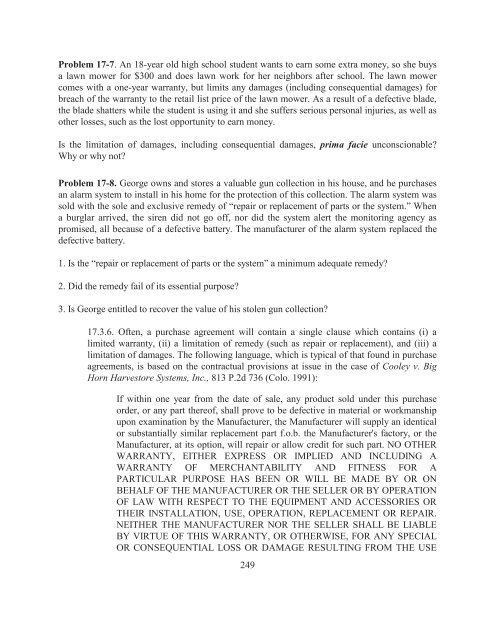Sales and Leases - A Problem-based Approach, 2016a
Sales and Leases - A Problem-based Approach, 2016a
Sales and Leases - A Problem-based Approach, 2016a
Create successful ePaper yourself
Turn your PDF publications into a flip-book with our unique Google optimized e-Paper software.
<strong>Problem</strong> 17-7. An 18-year old high school student wants to earn some extra money, so she buys<br />
a lawn mower for $300 <strong>and</strong> does lawn work for her neighbors after school. The lawn mower<br />
comes with a one-year warranty, but limits any damages (including consequential damages) for<br />
breach of the warranty to the retail list price of the lawn mower. As a result of a defective blade,<br />
the blade shatters while the student is using it <strong>and</strong> she suffers serious personal injuries, as well as<br />
other losses, such as the lost opportunity to earn money.<br />
Is the limitation of damages, including consequential damages, prima facie unconscionable?<br />
Why or why not?<br />
<strong>Problem</strong> 17-8. George owns <strong>and</strong> stores a valuable gun collection in his house, <strong>and</strong> he purchases<br />
an alarm system to install in his home for the protection of this collection. The alarm system was<br />
sold with the sole <strong>and</strong> exclusive remedy of “repair or replacement of parts or the system.” When<br />
a burglar arrived, the siren did not go off, nor did the system alert the monitoring agency as<br />
promised, all because of a defective battery. The manufacturer of the alarm system replaced the<br />
defective battery.<br />
1. Is the “repair or replacement of parts or the system” a minimum adequate remedy?<br />
2. Did the remedy fail of its essential purpose?<br />
3. Is George entitled to recover the value of his stolen gun collection?<br />
17.3.6. Often, a purchase agreement will contain a single clause which contains (i) a<br />
limited warranty, (ii) a limitation of remedy (such as repair or replacement), <strong>and</strong> (iii) a<br />
limitation of damages. The following language, which is typical of that found in purchase<br />
agreements, is <strong>based</strong> on the contractual provisions at issue in the case of Cooley v. Big<br />
Horn Harvestore Systems, Inc., 813 P.2d 736 (Colo. 1991):<br />
If within one year from the date of sale, any product sold under this purchase<br />
order, or any part thereof, shall prove to be defective in material or workmanship<br />
upon examination by the Manufacturer, the Manufacturer will supply an identical<br />
or substantially similar replacement part f.o.b. the Manufacturer's factory, or the<br />
Manufacturer, at its option, will repair or allow credit for such part. NO OTHER<br />
WARRANTY, EITHER EXPRESS OR IMPLIED AND INCLUDING A<br />
WARRANTY OF MERCHANTABILITY AND FITNESS FOR A<br />
PARTICULAR PURPOSE HAS BEEN OR WILL BE MADE BY OR ON<br />
BEHALF OF THE MANUFACTURER OR THE SELLER OR BY OPERATION<br />
OF LAW WITH RESPECT TO THE EQUIPMENT AND ACCESSORIES OR<br />
THEIR INSTALLATION, USE, OPERATION, REPLACEMENT OR REPAIR.<br />
NEITHER THE MANUFACTURER NOR THE SELLER SHALL BE LIABLE<br />
BY VIRTUE OF THIS WARRANTY, OR OTHERWISE, FOR ANY SPECIAL<br />
OR CONSEQUENTIAL LOSS OR DAMAGE RESULTING FROM THE USE<br />
249


















